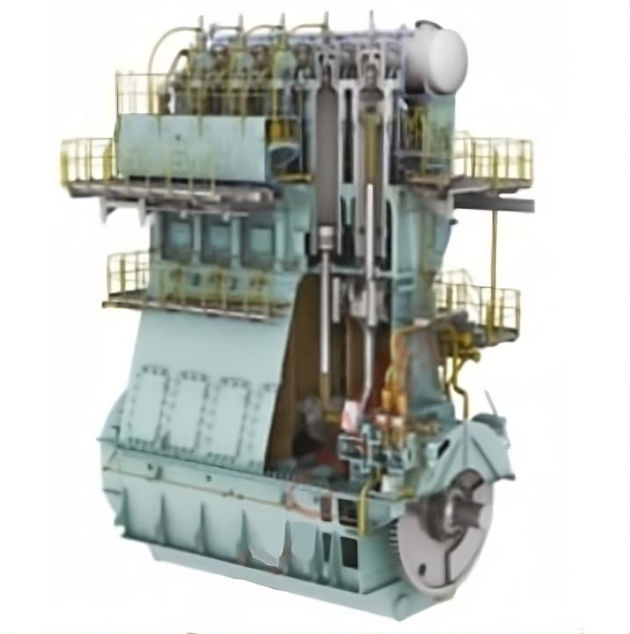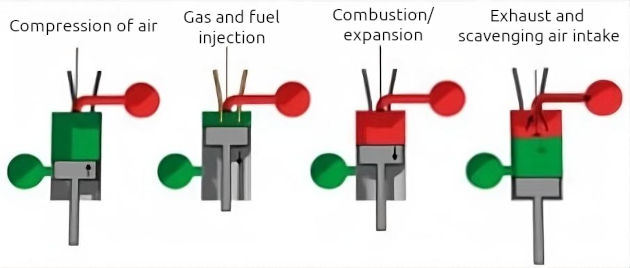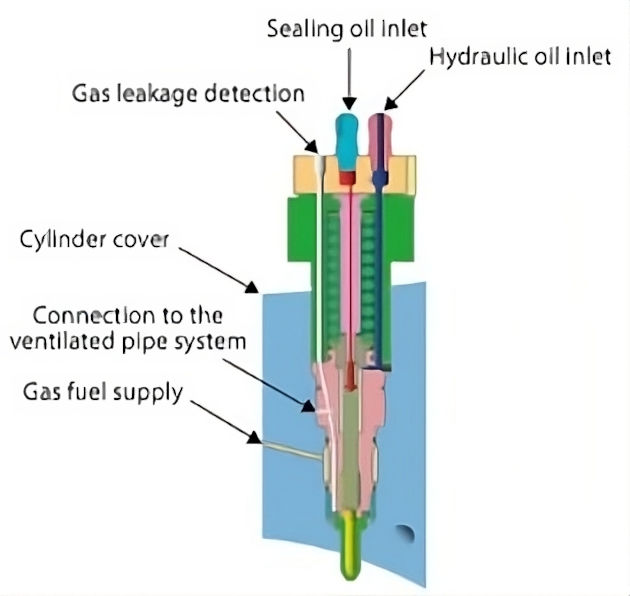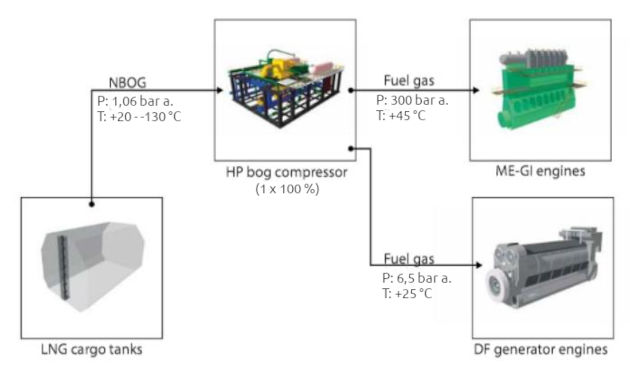With the introduction of the reliquefaction plant and gas-driven diesel engines, it is now possible to install high-efficiency 2-stroke diesel engines as prime movers, which offers significant savings in fuel consumption and reductions in environmental emissions. The ME-GI engine is a high-pressure, slow-speedgas-injection engine. In 2019, owners had the choice of two engine solutions for two-stroke, low speed propulsion for LNGCs, the ME-GI, by MAN Diesel and Turbo and the X-DF, by WinGD (previously Wärtsilä).
ME-GI engines optimise the capability of slow-speed engines by running directly off BOG or fuel oil if necessary, instead of re-liquefying the gas. This flexibility allows for economic optimisation at any point in time.

It is claimed that a 170 000 cm, ME-GI LNG carrier operating at design speed and fully laden in gas mode, will consume around 15-20 % less fuel than a similar ship with a Dual-fuel diesel electric/Tri-fuel diesel electric (DFDE/TFDE)TFDE propulsion system.
In gas only mode, both the ME-GI main engines and the DFDE/TFDE generators will operate on gas with a minimal amount of pilot fuel.
The ME-GI diesel engine, developed and marketed by MAN Marine Engines and Systems, applies the principle of non-premixed combustion (the ME-GI engine operates on the Diesel cycle). Gas injection and safety equipment are added on to a normal electronic engine.
The first LNG ME-GI ship was delivered in 2016.
The dual-fuel two-stroke engine is based on the combustion principle of operating on HFO or MDO together with high-pressure natural gas, where the fuel is injected and burned directly as opposed to the premixed or Otto-cycle combustion. Two or three gas fuel valves inject high-pressure natural gas to the combustion chamber and, to ensure an optimally controlled combustion, a small amount of pilot fuel is injected simultaneously via two or three conventional fuel oil injectors.

The ME-GI engine is equipped with additional safety systems that ensure a safe gas operation without requiring rupture discs in the scavenge air receiver, the exhaust gas receiver and in the exhaust gas piping.

These engines provide maximum fuel flexibility and the most competitive fuel can be utilised as the engine operates with the same efficiency on both gas and fuel. The Diesel cycle ensures stable gas combustion under all weather conditions, without any risk of misfiring or knocking.
All qualities of LNG can be burned with the same efficiency as the engine has no specific requirement with regards to the methane number. The dual-fuel engine can operate on natural gas in the load range from 10 % – 100 % load and can combust any ratio of natural gas and HFO/MDO.
Read also: Dual-Fuel-Electric LNG Carrier Propulsion
The ME-GI engine is always started on diesel and changeover to gas operation can take place at 10 % engine load. Once running, either HFO or MDO can be used as pilot fuel.
Service experience has shown that a ME-GI engine delivers significant reductions in CO2, NOx and SOx emissions.
ME-GI ships experience negligible methane slip during gas operation. This leads to a reduction of greenhouse gas emissions of up to 22 % when compared to fuel oil only.

LNGCs with high pressure, gas injected, slow-speed diesel engines require a multi-stage piston type Usage of Natural Gas Compressors in the Gas Production Operationsgas compressor for gas supply (300 bar) to the ME-GI engine. The compressor can also be utilised to supply the partial reliquefaction plant, with GCU and DFDE generators extracting the gas before the final discharge of the compressor.

As a safety feature, the gas pipeline through the engine room is of annular stainless steel construction, with the outer pipe purged and constantly checked for methane ingress. Additional safety measures are required by the IGC Code, including gas detection devices, pipe venting/purging/inerting system, a silencer at the open end of the venting line, control and safety equipment, etc. The length of gas pipes in the engine room should be kept as short as possible and a quick closing shut-off device, the master gas valve (MGV) in the gas supply line outside the engine room, should be fitted.
| M-type, Electronically Controlled, Gas Injection Engine (ME-GI) | |
|---|---|
| Advantages | Disadvantages |
| Proven and efficient concept of “Diesel cycle” | Depending on engine configuration, in-port maintenance may not be allowed |
| IMO Tier III compliance without additional equipment | High fuel gas pressure – 300 bar |
| Lower specific fuel oil consumption (SFOC) | Minimal maritime operational experience and development work ongoing |
| No methane slip | Maintenance more than steam turbine plant due to diesel engine requirements |
| No compromise in engine performance | GCU or reliquefaction plant required to handle excess BOG |
| Design readily lends itself to twin screw arrangements | Reliability of the high-pressure gas fuel system |
| Particulate matter emissions reduced to almost zero | Power consumption in auxiliaries |
As operational safety is paramount, sensors will cause shutdown of the MGV in alarm conditions.
